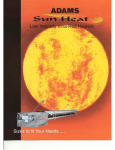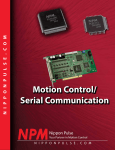Download March 2008 - Crawford Broadcasting Company
Transcript
The Newsletter of Crawford Broadcasting Company Corporate Engineering MARCH 2008 $ VOLUME19 $ ISSUE 3 $ W.C. ALEXANDER, CPBE, AMD, DRB EDITOR and melt back into the woods before the police arrive. An Ongoing Concern Even if the police arrive immediately, they still have In past issues of The Local Oscillator, I have time to run into the woods before the cops can get in dealt with the growing problem of copper theft. It’s the gate. nothing new. AM ground systems were being In the WXJC case, the thieves took all the unearthed 20+ years ago for beer money. Today, they strap and dug out the screen at the tower bases. That’s must be buying dope with the proceeds. a real pain to fix and an even bigger pain to secure, Stephen Poole will tell you in these pages all but maybe we should be more concerned about the about his unhappy experiences over the past month tuning components in the antenna tuning units. with copper theft at the WXJC(AM) site. We really We’ve seen evidence of on-site “testing” by the expected it and were not particularly surprised when thieves to see if copper is present… the cutting and it happened. We had even purchased a sophisticated peeling back of the jacket on a transmission line, the video surveillance system for the site, but it had not scratching through of the paint on a strap to see if it’s yet been installed because of other priorities, namely made of copper, etc. I can’t help but think that sooner a pattern problem with the nighttime facility at that or later, they will get wise to site. Stephen, Todd and the fact that the coils in the Jimmy had been running tuning units are made of radials and looking for plated copper. When they sources of reradiation. Now start hacking those up, we’ve they’ve got a much bigger got a much bigger problem problem on their hands with than we have now. virtually all the copper gone At the end of the from all five tower bases. day, protecting our Needless to say, the transmitter sites, whether reradiation/pattern problems they are AM or FM, still are now on the back burner. comes down to deterrence This whole episode and detection. has again brought to the Deterrence is forefront the question of how to deal with copper theft at arguably the most important Eyes everywhere... the video surveillance system of these two facets of site remotely-located, unmanned at the WXJC site includes a dedicated camera on protection. If we can deter transmitter sites. Video each tower base and a steerable pan/tilt/zoom surveillance is a good place the scumbags from entering camera for general surveillance. to start, and it was certainly the site (or a tower base area instrumental in the capture of or the transmitter building) the armed copper thieves that were hitting the in the first place, we’ve won the battle. Fences are a Birmingham Red Mountain tower site on a regular good first line of deterrence. If it’s going to take a basis last fall. But these scumbags know they’re on thief awhile just to get in, he may well move on to camera and they wear hoods, masks and gloves. And easier pickings. But we have to realize that no they know they have some time to do their evil work practical fence is going to be 100% effective. Copper 1 The Local Oscillator March 2008 thieves often come fairly well equipped with tools (the ones that hit WXJC evidently came with pneumatic tools and an air compressor!). Getting through even the sturdiest fence isn’t a huge problem for those so equipped. Visibility is another aspect of deterrence. For years, we have enclosed our tower base areas with wooden fences. The reason we used wood is because it’s non-conductive and we don’t have to ground it as we would a fence made of galvanized steel. But another name for a wood fence is “privacy fence.” Looking at the video from our surveillance system at WXJC when the thieves came back the following week, all we could see once they cut the lock and entered the base area was moving shadows. A chain-link fence provides no privacy. By brightly lighting the tower base area (using wire-meshed “security” light fixtures that will resist breakage from rocks being thrown at them) and using a chain-link fence, the thieves will have to work in plain view of our cameras and anyone that happens by. That will further serve to deter them. Clearing trees and brush from the frontage is another step we can take. There is a good bit of traffic on the road that runs by the site. It serves several businesses and a nearby residential area. If we clear out the trees and brush along this road, the view of the entire site will be opened up to passers by. Detection is itself another form of deterrence. If the thieves know that an alarm will sound and police will be notified when they enter a tower base area, they are likely to move on. At WXJC, we now have both the transmitter building and the old transmitter building (now used for storage) alarmed. The alarm panel has a zone expansion unit that will allow us to alarm each of the tower base areas with magnetic sensors on the gates and with pressure pads or trip wires. We can also use the motion detection feature on our video surveillance system to trigger an alarm. Clearly, we are going to have to be both creative and aggressive in our approach to site security. No more will it be sufficient to put up a fence and a few lights and call it good. We’re going to have to use any and all means available to us to protect our facilities. does. I experience that regularly here in Denver on an FM multicast stream I like to listen to. In certain areas, particularly at a certain stoplight a couple of miles from my house, the stream drops out and goes silent, at least until the light turns green and I drive out of the low-signal area. That’s a whole different situation than the HD-1, which also drops out in the same area but goes mostly unnoticed with the blendto-analog feature. So while boosting the digital power would certainly make a difference in the digital coverage area (which is, without a doubt, smaller than the analog coverage area), it would also cause adjacentchannel interference in some cases. Out here in the West, allocations tend to be wide open and fully-spaced. East of the Mississippi is a different story, however. There are lots of grandfathered short-spacings, lots of grandfathered super-power class Bs (we own two of them), and the allocation picture is otherwise really tight. In view of that situation, do we really want to do this to ourselves? My personal view is that a good bit of the digital coverage problem lies in the receiver. Having owned several first- and second-generation aftermarket and tabletop HD Radio receivers, I can attest to the fact that they do not have the “ears” of even a “standard equipment” automobile factory radio. Why is this? Is there something in the HD Radio architecture that dictates lower sensitivity and poorer selectivity? Things do seem to be getting better with later generations of HD Radio receivers. Hopefully the OEM radios that Ford, BMW and others are offering this model year have solved this problem. If and when the FCC authorizes an FM digital power increase, we’ll take a hard look at each and every one of our FM stations before we crank up the power. The last thing we want to do is cause problems for our neighbors. I only hope they are reciprocally cautious. Modeling Since the Numerical Electromagnetic Code made its first public domain appearance almost 30 years ago, I have experimented with antenna modeling in both the Amateur Radio and broadcast worlds. My modeling attempts met with mixed results, especially early on, attributable mostly to a lack of understanding on my part of the intricacies of the modeling art. In the mid-1990s, we purchased a broadcastspecific NEC-based modeling engine that was fairly easy to use. It “wrappered” the NEC core with an I/O FM HD Power Increase It’s been in the trade news lately that a move is afoot to allow up to a 10 dB increase in digital carrier power level in FM HD Radio systems. The argument for this, which has some merit, is that the multicast (HD-2, HD-3, etc.) streams do not have an analog “fallback” as the HD-1 2 The Local Oscillator March 2008 system that spoke in terms familiar to broadcast engineers, namely tower heights in electrical degrees, face widths in inches, element spacing in electrical degrees and element orientation in clockwise compass degrees. The results I obtained using this package were excellent. I have written before in these pages and elsewhere of how modeling directional arrays that I was building or rebuilding saved me days if not weeks in the tune-up process. I am a believer. Over the last few years, the antenna modeling art has progressed farther still. The NEC and MININEC cores have not changed, but the “wrappers” have improved. Mostly, however, the volume of the collective experience of professional antenna modelers has grown considerably, and with experience comes proficiency as well as knowledge of what works and what doesn’t. It’s this proficiency and collective knowledge that have been behind the industry acceptance of AM performance verification based on method-of-moments modeling. The issue is currently at the FCC for consideration, and many broadcasters and consulting engineers (as well as some engineers at the FCC, I suspect) are eagerly awaiting a set of new rules that will allow broadcasters to trade their field intensity meters for antenna modeling platforms. One thing we have learned over the years of our modeling experience is that consistency is supremely important. It’s possible to get erroneous results if the model is not set up and run correctly. I won’t go into the details, but such things as segmentation, segment alignment and environment affect the accuracy of the model. To get everyone on the same page, the NAB has hosted a couple of antenna modeling seminars in recent months, taught by the masters – Ben Dawson, Ron Rackley and Jerry Westberg. Due to scheduling conflicts, I was unable to attend either of these seminars, but I hope to get in on one in the future. But in the meantime, I wanted some greater insight into the antenna modeling art. Fellow SBE Director and Education Committee member Ray Benedict mentioned that he had taken an online antenna modeling course offered by the American Radio Relay League (ARRL). I looked into the course and enrolled. I’m a good ways in now and let me tell you, it ain’t for sissies. While the course targets serious Amateur Radio experimenters, it not a course for “amateurs.” I have gained a whole new level of understanding of the modeling art and an appreciation of the power of the underlying core. This won’t take the place of the NAB seminar (and I hope to work out an alternate venue for this seminar through the SBE in cooperation with the NAB), but it certainly lays a good foundation. There’s no doubt in my mind, the future of AM antenna work will be based in accurate modeling. 3 The Local Oscillator March 2008 The New York Minutes By Brian Cunningham, CBRE Chief Engineer, CBC – Western New York now. He came equipped with a full-blown console and engine, and hands-on experimentation was welcomed. I have previously installed and programmed several of their products, so I was very up-to-date with the system. Still, I learned about some newer technology that they have introduced since my last installation. In all, the meeting was very informative and well worth the time. I look forward to next month’s meeting, hopefully with more radio engineering presence. Hello to all from Western New York! I had hoped to include an equipment evaluation this month on my new LG Technologies LPT-3000 spectrum analyzer, but I have not had the time to adequately put this new piece of test equipment through rigorous testing. I did, however, use the analyzer recently side-by-side with the corporate Anritsu spectrum analyzer while setting up the nighttime IBOC for WLGZ, and the two reported similar results. In a nutshell, I found the LPT-3000 very easy to use, and navigation through the system menu was easy. The one function I found very easy to use was the Occupied Bandwidth Measurement, which gives you a pass/fail indication right on screen. Perhaps next month I will be able to give a full, detailed report on this analyzer. The only negatives I have found so far are that the analyzer will not accept a modulation sample directly from the transmitter without using an external attenuator, and that the unit does not come with a printed user’s manual (it has the manual in PDF format on a CD-ROM). More to come. In February, I had the opportunity to attend the SBE Chapter 133 (Buffalo) monthly meeting. I was very disappointed that I was only one of two radio engineers at the meeting; the remainder consisted of TV engineering personnel. I have talked with other radio engineers in our market to try to get more interested in joining the SBE so we can give radio more presence in the meetings, but so far, not much interest has been noted. I will continue to solicit the support of other radio engineers in our market to at least attend one of the meetings to see what it is all about. Then they can decide if joining will benefit them and their employer. In this past months meeting, we had a presentation from Frank Grundstein, sales representative of Logitek, demonstrating their router-based television console, which is very similar to the radio broadcast control surfaces they have been selling for a number of years WDCX – Buffalo The problem I reported on in last month’s column with the Comstream ABR-202 satellite receiver dumping its memory has mysteriously vanished as quickly as it came. For some unexplained reason, the receiver would completely dissolve all programming and begin searching aimlessly for any signal. After a full reload of the programming, it would work well for a few days, then dump again. Comstream has not noted a trend of this happening with other receivers, and had no idea as to the cause of the failure. I suspect that the problem was power related, as we were having occasional brown outs and full service outages during this time period, which were weather related. If the problem resurfaces, I will request that NYSEG, our electrical provider, install a recorder on our incoming electrical service to detect any abnormalities. I had hoped that we would approach nearcompletion this month on the move to the new WDCX transmitter building, but the weather has not cooperated with us in getting the outside work completed. Western Tower Service has yet to complete the fabrication of the ice bridge between the tower and building. Numerous weather-related circumstances have delayed the installation of the ice bridge, along with the moving of the transmitters from the old building to the new one. That cannot be done until the bridge is in place to support the antenna feed lines. Perhaps March will see 4 The Local Oscillator March 2008 better weather conditions to finally get this project into full swing and completed. of perhaps 40 percent of the initial coverage area. Once I had the daytime nailed, I switched the array into night mode and looked at the spectrum on the Anritsu analyzer. The digital carrier was –28db down from the analog carrier. However, the out-of-band emissions were well above the –65db mask. I adjusted the mag/phase delay to get the OB emissions down to a respectable level, and when satisfied that we were under the mask, I then began driving around the area to check reception on my in-dash HD receiver. Our HD reception was horrible; the HD signal would not stay locked but only for a few seconds. I then went back to the transmitter site to see if something had drifted, but the spectrum looked the same as before. I did notice that even the Day-Sequerra modulation monitor would not stay locked, so I knew that something was out of kilter. A quick call to Cris revealed that what I was seeing was normal, but further delay adjustments were in order to get the HD to lock right. Well several hours later, I was still unable to get the signal to stay locked for more than a few minutes. I will have to get someone to man the controls at the transmitter site while I get out in the field with my receiver and cell phone. This way I can have someone make the adjustments in the delay while I check lock time on the receiver out in the real world. More on my findings next month. WRCI / WLGZ – Rochester A lot of my time this month has been spent in Rochester, tying up loose ends from the recent digital console installations. Once all that was done, I was informed that the Legends format, previously aired on WLGZ-AM, would now be heard on our FM station full time, and the AM station would simulcast the Legends programming during the weekdays and specialty programming on the weekends. This meant flip-flopping the studio feeds to the transmitters, along with associated PAD data that accompanies the programming. So far, everything has been running smoothly with only a few changes requested for each studio. Most of those requests have been in the console configuration. I envy those of you who have routerbased consoles, as you can change configurations with the touch of a button or the change of a macro in the engine software. Perhaps someday…. I recently attempted, and I use this term loosely, to tune up the WLGZ NE-IBOC exciter for nighttime operation. As we have different power levels between day and night operations and utilize six towers for night versus four towers for daytime operation, the settings in the NE-IBOC are different between day and night. I first tweaked up the daytime spectrum, which resulted in a considerable increase in the digital coverage area. I noted that the WLGZ-AM HD-R could be heard to within 10 miles or so of Buffalo, an increase That about wraps up another month here in the great northeast, and until we meet again here in the pages of The Local Oscillator, be well, and happy engineering! 5 The Local Oscillator March 2008 The Motown Update By Tom Gardull, CBRE Chief Engineer, CBC–Detroit radio. Its AM performance was actually disappointing when I now compare it to JVC. It is still amazing to listen to our WEXL when they are playing music. Clarity, stereo separation, and no noise make it comparable to FM. AM HD can live up to its promise. We just need better radios for the consumer. One local 50 kW AM has turned off its HD. They had an hour-long off-air outage during morning drive. When they came back on, there was no HD. There has been no HD signal for over three weeks from them, and they had been running day and night HD before their problem. I hope they have not given up. WMUZ celebrates 50 years of broadcasting this year. There will be some kind of anniversary event later this year. WMUZ had to be one of the early FM broadcasters in Detroit. FM was not popular in 1958, but certainly is now. Our AM 560 WRDT passed its 50-year milestone last year. WEXL1340 dates from the late 1920s and is probably about 80 years old. WMUZ’s HD-2 station (called “Z2”) started in 2005 and has a way to go before a significant anniversary event. Weather has only caused a few problems this winter. Rainy drizzle causes ice build up 500 feet above the ground. Our FM system folds-back the power. We had to operate several days with a high VSWR and a little lower power on FM. WRDT iced up its 400-foot towers and pushed the phase and ratios to their limits. Then in the middle of Friday afternoon, everything snapped back to normal as the temperature climbed above freezing. It has been cold since then but no more icing. Springtime weather is about a month away, and then we can start outdoor projects and catch-up on all the winter wear and tear of the buildings. Irritating gremlins have been our problem this past month. We had a lot of phone line problems that would come and go. Some lines would go dead and it would take the phone company two weeks to fix them. Static and hum would bother other lines and then clear up on its own. One of our T1 paths had audio oscillations but we cannot tell if the problem is with the new Oslo terminal equipment or a defect in the phone circuit. Rebooting the Oslo fixes the problem, but that probably restarts the 0 and 1 sequence on the T1 also. The T1 problem produced bad audio and would not operate the remote control circuit. Then I found I could not dial into the Burk RC to remotely switch to the ISDN audio backup. Our local telephone at the WEXL transmitter site was dead, and that could point to local cable pair problems involving the T1 as well. I had to drive to the transmitter site to make the audio switch and then pull the Oslo plug. I will pass along to APT a request to add a remote restart to its Oslo menu. Our studios claim to have dropped calls during talk shows but lines check out okay. I wonder if callers just gave up waiting while long-winded hosts were talking. The dropped calls never happen once the caller is on-air. Our NE-IBOC HD-R exciters have worked well after some freeze-ups last month. I can observe that that HD reception is very dependent on AM radio sensitivity. Since involuntarily switching from my Kenwood car radio to the JVC, my pickup area has doubled. My car had been broken into and the Kenwood radio smashed out of the dashboard while in a church parking lot. I hope the manufacturers spend the R&D capital on improving sensitivity. I did not know any better when I had the Kenwood car 6 The Local Oscillator March 2008 News From The South By Stephen Poole, CBRE, CBNT, AMD Chief Engineer, CBC–Alabama A guy leaves his job as a truck driver, then returns and “borrows” a truck from the back of the yard. He takes the stolen truck into Tennessee and drives right onto a sales lot filled with new aluminum flatbed trailers. He hooks one up, pulls it across the state line to his home in Alabama, then returns the truck. When he gets back home, he cuts the flatbed into scrap and sells it for a bunch of money. Quite a haul (pun intended); there’s a lot of aluminum in one of those things! The guy was playing one of the oldest tricks used by crooks: if you act like you’re not doing anything out of the ordinary, most people won’t give you a second glance. Be honest, if you saw what looked like a driver for a big trucking company hooking up a trailer, would you suspect anything? Who on earth would steal a 53-foot aluminum flatbed in broad daylight, for crying out loud? But here’s the punch line: the crook got away with this three times before he was finally caught. Another great example of this is the crook that stole a van from a plumbing company and quickly drove it into a nice, upscale neighborhood. Once again, no one paid him a bit of attention. The bad guy pulled up to a house and, after confirming that no one was home, crawled underneath and stole all the copper pipe. The police had just begun interviewing the plumbing company employees by the time that he’d already ditched the van, headed to a scrap yard with the copper. All told, the caper took him less than an hour. I share these stories to make a point: if you think that metal thieves nowadays are just rednecks or druggies out to make a quick $20, you’re going to be sorry – as I was this past month when the WXJC site at Tarrant, Alabama suffered phenomenal damage from these people. Stories like these show just how brazen the “scrappers” have become. With prices on recyclable metals at all time highs, dishonest people have a huge incentive to steal these things ... and the scrap yards have every incentive to buy them. It’s not a bad idea to treat copper and aluminum the same as you would gold and silver. The fact is, you are more likely to be hit than a jeweler. For one thing, your transmitter sites tend to be isolated and unattended; even if you have an alarm system, it takes time for the police to respond. For another thing, thieves prefer these “lesser” metals because they’re actually easier to dispose of. (That needs to change, by the way, and more on that later.) Unfortunately, I have learned more about this in the past three weeks than I ever wanted to. The second weekend in February, thieves hit WXJC’s 5tower array and took as much copper as they could easily get their hands on. They didn’t just steal the exposed copper strap, they dug down into the soil around the tower bases and destroyed the ground system. In the process of making maybe $100 off of scrap copper, they managed to do tens of thousands of dollars worth of damage. Adding insult to injury, they came back the next weekend and did it again – in spite of the fact that we clearly had video cameras to record them! As I write this, WXJC is operating at reduced power until we can fully secure the site and complete repairs. We reported both thefts to the sheriff’s department and two detectives from Jefferson County’s copper task force came out to investigate. They walked around the site with us, asking questions and sharing some valuable tips (and stories, such as the one about the flatbed thief). According to them, the crooks have indeed become bold nowadays, hitting the same victims again and again. You may recall my mentioning in a previous issue about phone service being interrupted several 7 The Local Oscillator March 2008 times to the WXJC-FM site in Walker County (just detectives know most of them – their names, how they normally operate and where they live. I had outside of Jefferson County). The detectives were quite familiar with that case; it was caused by a spotted a suspicious-looking car outside the site a few days before, and when I described the driver to them, couple of thieves repeatedly cutting down a 900-pair phone cable for scrap. Of course, this would knock they rattled off some names and said, “We’ll check them out.” out the phones (including 911 service) to a large rural area, but the thieves didn’t care. The phone company While the typical metal thief isn’t a genius would repair it and the crooks would come right back (if he was, he’d know that a real job would pay more and steal another length of line, causing another with less risk), he is reasonably good at what he does. massive service outage. They were only caught after He may have started as a petty thief, stealing phone an extensive trap and “sting” operation was set up to cables and brass flower pots, but he has learned. He’s nab them. going for bigger targets now, and he knows how to Some thieves are disable or work around most even crawling under cars surveillance and alarm now to steal catalytic systems. If he can’t figure converters! They can easily out how to disable it, he may net hundreds of dollars in deliberately trigger your just a few minutes by alarm to see how long it scrapping and selling the takes the police to respond. Or, he may repeatedly set it platinum “beads” inside. The off to make you think it’s lesson for us is obvious: if “falsing,” hoping that you’ll they’re hitting middle-class disable it. Unless he’s a pure folks in shopping centers and newbie amateur, he will upscale neighborhoods, our wear a mask and gloves to isolated tower sites are really prevent identification on attractive to the thieves. Let video, too. me pass on some of the tips Newly copper-free zone at the base of WXJC He’ll research your that the detectives shared tower 5. The thieves even raked up the copper site before he hits it, so pay with us, possibly shattering a screen under the dirt. attention to things like a car few misconceptions and or truck that parks near your false notions, so that you can site for no obvious reason. (Ask any cop: thieves will protect your sites more effectively. rarely walk a long distance; there will almost always be a vehicle nearby.) This is just good security, First: You Are a Target anyway; it’s a transmitter site, not a parking lot! Be Call this the mental prep and get this through polite, but ask them to leave. Post “no parking” and your head to start with. Just because you’ve never “off limits” signs at the perimeter. had a problem in the past, don’t assume that you’ll be Remember, he’s brazen! If the crook sees okay in the future. Just because you have a site that you working at the site, he might even stroll over and has never been bothered, don’t assume that it never engage you in friendly conversation to disarm you will be. You could be hit by thieves at any time now. and to obtain information. “Wow, I had no idea you As the stories above illustrate, even if your had so much copper out here! Aren’t you afraid transmitter is in a well-watched, populated urban someone will steal it?” If you start boasting about area, the bad guys might steal a van or service truck your alarm system and hidden video cameras ... well, so that they’ll look like they have a right to be there. you’ve already blown it without realizing it! Most onlookers won’t think anything is amiss. The thieves talk to one another and share tips, and unfortunately, the ones in this area have Second: Know Thy Enemy learned that AM sites are a potential goldmine Nowadays, the typical metal thief is a white because of all that pure, thick copper around each male, but of no specific age group: the deputies told tower base. They also have learned that AM sites are me that their ages range from late teens to early 60s. “hot;” don’t expect that to deter them. In our video, He’s probably a repeat offender who has been doing you can see the guys wearing thick gloves and it for some time. He’ll be put in jail, then go right staying away from the feed lines between the bowl back to stealing copper and aluminum as soon as he’s insulators and the tower bases, even though they’re released. One thing that startled me was that these 8 The Local Oscillator March 2008 nice big copper pipes. They even opened the ATUs, but didn’t take anything from inside of them, either. They went after the “safer” straps, ground screens and radials. As illustrated by the trailer thief mentioned above, greed is the metal thief’s one overarching weakness. If he thinks you’re an “easy” take, he’s going to hit you again and again. He will patiently watch and wait for you to repair the damage from a theft, then strike again to get that fresh copper. All of the old tricks, such as covering copper with tar or painting it a different color, won’t slow him in the least. This is why you should always report theft and vandalism to your local police or sheriff’s department, even minor incidents that you might be willing to overlook or dismiss. Law enforcement types like catching criminals and they know that the odds go up if they have a moron who keeps trying again and again. The detectives told us that they’d had a lot of success setting traps for repeat copper thieves, so take advantage of that. Fifth: Set Up a Multi-layered Defense 1. Quick response. Use a monitored video system if at all possible. Recordings are only useful for establishing dates and times; they’re generally worthless in court (the thieves wear masks, remember?). But if the video is monitored real-time, law enforcement can be called as soon as someone is spotted on the property. A cheaper alternative is to use a video system that can provide an alarm closure if it detects motion in specified zones. If you define your zones carefully to avoid false alarms while covering the critical areas, this can be almost as effective as live monitoring. 2. Slow the thieves until law enforcement can arrive. Ideally, you’d double-fence each tower base, with concertina (“razor wire”) between the two, but that’s very expensive (and a lot of work; don’t forget that you’ll have to carefully ground all that stuff at an AM site). A cheaper approach, and almost as effective, is to line the ground inside of a single fence with coiled razor wire, or to put up a strand of electric fence wire on insulators inside the security fence. You should discourage entry at any point except for the gate, which can easily be protected by motion detection or an alarm switch. Third: Be Prepared For Multiple Attempts by Different Thieves Okay: local law enforcement sets a tra0p and it works; they’ve caught the thieves! You can breathe easier and take a break now, right? Wrong! The detectives told me, and I quote, “Another group of thieves will just take their place within a month or two.” As mentioned above, the bad guys talk to one another now. If two thieves are in jail together, the first might tell the second about your site. “Man, that place was copper heaven!” If the second thief gets out of the pokey before the first one, he’s likely to give you a try. Ego even plays a part; the second thief will figure he’s “smarter” and won’t get caught. 3. Don’t wait for them to get inside a tower fence. Set up a perimeter; even a couple of strands of barbed wire with “posted” and “authorized personnel only” signs can make all the difference. If you mark your entire site off limits, the minute anyone crosses onto the property without permission, they’re trespassing. You can call the police right then, before the bad guys even get near your towers or transmitter buildings. 4. Mark the metal. Go ahead and mark large pieces of copper or aluminum with a scribing tool. You might wonder why, given that I’ve already said that the copper rarely stays at the scrap yards for more than a day or two. But you’re giving the police an incentive: if they know the thief might have marked metal in his possession, they’re much more likely to take immediate action. Even if it doesn’t work out, they’ll still appreciate the fact that you tried to make their job a little easier. Fourth: Scrap Metal Is Big Business Here’s the root of the whole problem: there’s a ton of money to be made in recycled metals. The scrap yards talk a good game and loudly protest their righteousness, but even a legitimate recycler could have a dishonest employee who’s willing to accept stolen metal for a cut of the money. And regardless of whether the yard is as crooked as a snake or completely legit, they receive tons of metal on a daily basis. They have to move it out fast to make room for more. The bad news is, even if you place identifying marks on all of your copper strap (and you should, of course), by the time detectives get to the scrap yard, it has probably already been compacted and shipped away. 5. Raise public awareness of the problem. Talk to your local law enforcement personnel. See if they have a copper or scrap metal task force and get to know the detectives. Offer to interview them on the 9 The Local Oscillator March 2008 air (as I said above, metal theft is affecting everyone now, not just us). They’ll know the local thieves and will have specific tips, appropriate for your area, on how to deter them. We don’t want to penalize or prevent legitimate scrap operations. Metal recycling is costeffective and environmentally-friendly; the last thing we want is for it to be stopped. (I myself have scrapped old coax for the company after a repair or upgrade to recover some of the costs of the job.) The whole reason why prices on copper and aluminum are going up is because demand is higher than supply; we need the recyclers. But just as pawn shops are now required to keep detailed records, so should the scrap and salvage yards. That’s the weakest link; if we require them to get religion, most of the problem will go away overnight. Make noise and start lobbying! That’s enough for this time; I’ve got fences to repair and replace, a new alarm system to finish, and – of course – a bunch of repairs to do to my poor transmitter site. Until then! 6. Lobby for better laws. This is probably the most important of all: work your government contacts through the station. Do some serious lobbying. Let’s get the SBE and NAB behind this, too. We need laws that require photo identification from anyone trying to sell scrap metal, and that the entire transaction be recorded on camera. These two steps would eliminate most theft, because it would make it a lot more difficult for the crooks to easily dispose of stolen metal. Call wireless operators and your local utilities to get them behind the effort; after all, they’re losing tons of money to this as well. Gateway Adventures By Rick Sewell, CBRE Chief Engineer, CBC–St. Louis As you may have read over the past couple of months, we have been attempting to install a Motorola Canopy system as a link between the KJSL and KSTL transmitter sites as a way to replace the telephone company provided T1 to the KJSL transmitter site. At the end of January, you may recall we only needed to install the antenna on the KSTL tower to finish the job. We were just waiting for the weather to break to allow the tower crew to get up to the 255foot mark of the KSTL tower and install the antenna. With this being one of those every fourth year occasions where everybody is promising “hope,” my hopes were high that the installation would be finished by now! Of course, with it being February the chances of halfway decent weather were not as great, but still I knew we always seem to get a few days here and there that are warmer than usual. We actually did get a few days break in the weather and the tower crew made their way into town. But then the weather turned during the day of the installation and that may have had something to do with the events that followed. The forecast had called for a partly sunny day with a high of 45. The sun never appeared and the day actually got colder, not warmer. As you can tell from the accompanying photo, the tower crew did get the dish up on the tower. Although it took them a while to visually point the antenna in the proper direction, they did get it to where the two sides were communicating. Then came the task of fine adjusting the aiming of the antennas at both sites for the optimal alignment. The Canopy system radios are located near the antennas and when armed for installation, they actually make an audible beeping noise to assist in the alignment process. They start making a low beeping tone and when they get connection, it makes a solid tone with the pitch going higher as the signal gets better. You accomplish this best by having one side adjusting first and then the other as many times as it takes to get the optimal alignment. That’s the theory, anyway. The dishes come with a threaded fine-adjustment arm, with nuts on either side of a bracket, for both horizontal and vertical adjustment. I took the time to explain this before the 10 The Local Oscillator March 2008 and deal with the fine adjustment down the road. This was a Saturday, so I was for sure not going to switch to the new system just yet. During the next day, I logged into the web servers of the Canopy radios to check how they were doing. It was a rainy, very gusty day, and this would be a good test of how the system would hold up. In the morning, I could already tell that something wasn’t right as the data rates began to drop between the sites. By afternoon, there was no connection between the sites at all. I knew one or both dishes had moved in the 50 mph wind gusts we had that day. My guess was the one that was actually missing part of its hardware. Sure enough, when I checked both sites on Monday morning, the one at the KJSL site looked like it had not moved and eighth of an inch. However, the one 255 foot up the KSTL tower had moved 90 degrees to the east. I had already planned to look for the missing crew climbed the tower and mounted the antenna. We had radios so that I could communicate with them as they made the adjustments. I was logged into the web server of each site’s Canopy radio so that I could follow the results of the adjustments. When I asked the crew at 255 feet up the KSTL tower to make some fine adjustments both vertically and Tower crew prepares to mount the Canopy dish horizontally and then listen for the highest pitched tone, I watched them grab the dish and move it by hand. I of course let them know that they could not fine adjust the dish that way. I reminded them that there were fine adjustment arms specifically for this purpose. Still they continued to try and adjust the antenna with their hands. While we got the adjustment to where we had a useable signal, I still felt that we could have obtained a higher signal if they would just make the fine adjustment procedure properly. Snow and ice were beginning to fall, so I decided that this crew was not going to “get it” and called them to tighten everything up and come down off the tower. When they finally came down, they actually brought the bracket that was used to make the fine horizontal adjustment to me. The confessed that when they were making their initial tightening they had dropped the nut, bolt and spacer that held the horizontal adjustment arm to the dish. This bracket also had one of three U-bolts that held the dish to the tower. Obviously, I expressed my frustration to the head of this crew over what just took place. I wanted to make sure that they understood that they needed to return to make this right. I let them know the job was not finished! With them being over a five-hour drive away, they were not very happy to hear that. Still, we had a usable signal and I was hopeful that we could move to the new system soon Aiming the dish... sort of hardware. I could easily get the nut, bolt, and washer combination at any hardware store. However, the spacer was a vital part of this installation. I could easily see that without it, the whole antenna would vibrate in the wind. I tried to see if I could fashion one by cutting a pipe to the right length. But after exhausting my search, I could never find anything with the right diameter. So we had to turn to the manufacturer to get that spacer. At the time of this writing I am waiting the part to ship. I expect it will be here in a few days. When we have some decent weather, we can finally get this installed correctly. So, once again, I have high “hopes” that this will be finished by next month’s issue. 11 The Local Oscillator March 2008 Catalina Tales By Bill Agresta Chief Engineer, KBRT Greetings from Santa Catalina Island! With each new month here on this little island, we seem to encounter new surprises. This has once again been the case this last month as I continue to try to get the company we hired to install our new satellite Internet system to get out here to install it. After having a very productive couple of months, getting our tower reguy completed in January and our new fence installed last month, it was frustrating to hit this kind of roadblock. Although it seems pretty simple to me to get to Catalina Island – just hop on a boat and go – getting over here becomes a mental problem for many of the service companies we hire. As I am dealing with this and doing what I waterway just fell off. I must say, it never gets boring here! There’s always a surprise waiting just around the corner! Speaking of surprises, that road closure I wrote about last month has become a growing problem for us. We are literally locked down at our transmitter site from 7:00 am until 1:00 pm unless I happen to make it into town before 7:00. In that case, I am then stuck in town until after 1:00. They are supposed to open the road between 9:30 and 10:00 to let traffic pass, but I found out the hard way when I went into town early one morning that is not guaranteed. I ended up sitting and blowing my entire day until the road finally opened at 1:00! Now I am being told that they are planning to close the road down for “structural modifications.” This one sounds really fun as they plan to close the road completely for several months. This is becoming pretty entertaining! How are we supposed to get food and other supplies during this time? I guess Cris is going to have to do our shopping for us on the mainland and fly it all over to us in that new company helicopter we will be needing…LOL! Now I don’t want to sound like all I have to write about is negative this month but… well… things are getting tougher here and at an exponential rate it seems. Let me make clear that I am very blessed here in many respects as amongst other things, we have one of the most awesome views in the world. I get to get up in the morning and look out my window over green rolling hills with herds of buffalo grazing and a beautiful blue ocean spanning from just beyond my driveway to the mainland. On a clear evening, my view over the ocean is of the lights on the mainland. I can see all the way from San Diego through Orange County, Los Angeles on through Oxnard, and it’s breathtaking. I thank God for the opportunity to experience such a blessing. At the same time, this all comes with a cost. As I have written about many times, many of the tasks you would perform without issue on the mainland can be nearly impossible (or at least very A weld failed on the gate opener solar panel bracket in high winds can to get them here ASAP, I am now also working to get the fence company back to the island as many issues have begun to surface with the job they did installing our new perimeter fence. It’s only been in place a couple weeks and already I have parts of it literally blowing away in the wind. One of the solar panels that power our gate opener blew off its mount while at the same time the flood gate over our 12 The Local Oscillator March 2008 tough) here on the island. This has become the case with getting our truck and our tractor repaired, as the island-based mechanic we have used for years is no longer available and soon will be moving off the island. This makes what used to be a fairly simple task into a major project. There are simply no mechanics left here that we can trust as we continue to see more and more dangerous failures happening. The Conservancy road we travel that is our only access to and from our transmitter plant is in such bad condition it is taking its toll on our truck like never before. We are constantly dealing with suspension and front-end issues, and now we are beginning to witness many other vehicles literally falling apart, one of which happened not far from our driveway. One truck lost its steering and then the entire front end literally fell off. Now it is time for our truck to get some work done so we do not become one of these stories, but we will need to barge it over to the mainland (and that all by itself is very expensive). I will need to go over on a boat, get a ride from someone at our studio to go to the barge terminal and get it, then drive it to a dealer. We don’t have any rental cars on the island, so unless you have a friend that happens to have an extra vehicle sitting around, you are stuck. Since a vehicle permit requires a hearing and you must show an undeniable need to have a vehicle on the island, they are quite scarce and the few that are here are always in use. You just don’t find people with an extra car sitting around. So here is yet another island factor situation I will be forced to deal with this month. The “road” to our site takes its toll on front end components To top it off, our tractor got a flat tire while the fence crew decided to drive it through a field full of cactus, so I will be removing the entire rear wheel and trying to find someplace on the mainland I can send it to get repaired. Some of these things can get pretty bizarre, but it’s all in a days work here at the Catalina Island transmitter site. Until next month, the Lord bless you and keep you; the Lord make his face shine upon you and be gracious to you; the Lord turn his face toward you and give you peace. 13 The Local Oscillator March 2008 The Chicago Chronicles By Art Reis, CPBE, CBNT, AMD Chief Engineer, CBC–Chicago I love Charles Osgood, the CBS Radio commentator. Many years ago, he wrote a book entitled, “Nothing Could be Finer than a Crisis that is Minor in the Morning.” I feel pretty much that way, too, except make that a monthly – not a daily – thing, if you don’t mind. Nothing cures writer’s cramp like a few good crises, and this month, we have a couple of beauts. I may need your help as to what and why on both, so read on and see what you can contribute. didn’t hear from him again. As if I expected any thanks for this. It’s not like I haven’t mentioned this before, although it’s been awhile, but here’s the deal: AES audio is not at its best where a very large amount of bass response is required, at least not in a radio transmission situation. That includes such high bass-demanding formats as Hip Hop, Black Gospel, or even a ‘dusties’ format, all of which we use here in Chicago. If you’re running a format such as classical music, it’s not such an issue, but head-bangin’ bass isn’t going to happen in AES. I formulated a hypothesis for this a long time ago, using an analog comparison. When using 30 i.p.s. analog tape recording, low-end audio preemphasis is a must, since the tape flux at the low frequencies changes at such a low rate across a given distance on the tape that the information is lost in the recording process. I suggest that the situation is somewhat similar for AES. At low frequencies, the bit rate change is too gradual to allow for a proper amount of audio response in the A/D process when the bit-rate is high. I don’t know that for a fact but it’s the only explanation that fits all the data. The point is that there are places where digital audio works best, and that includes most places. However, there are other areas where only analog will do, and in considering the listener experience, it is best to keep that in mind. And, wouldn’t you know, we may have found another example of this. We’ve been off the air with our HD-2 signals for a while because of royalty issues, but we’re gearing up to return to it on a moment’s notice. To put it cryptically, someone may someday make us an offer we can’t refuse, and we’d better be ready. One area of particular concern is the STL. We currently have three STL paths to each transmitter site except Kirkland (WYRB). Two of our paths are over the air, that is, a StarLink and a 6000 series (all Moseley, of course) sharing a common antenna. There is also our ISDN backup. When Analog May Be Better..... I recently received an email from a chief engineer at a station group up in Milwaukee. Since the email he sent was really flattering and his company has no stations in the Chicago market, I wrote him back. What the heck? Give me the right circumstances and I’m easy. He told me that he was, shall we say, awed by the audio quality of Power 92, which apparently can be heard quite well in Milwaukee, likely because of tropo-ducting, which regularly takes our signal right up Lake Michigan, often over 100 miles. In particular, he said he loved the clean, full-bass audio we had. He wanted to know my secret because he couldn’t duplicate it. I mentioned to him the type of audio processor we’re using (without mentioning settings, obviously – as if I knew them anyway). I also mentioned our secret weapon, James Kelly, a.k.a. (affectionately known as) Eagle Ears, and the fact that he was ours and was not available for use by other stations. He doesn’t have him. We bandied about a couple of other possibilities, and then something else occurred to me. I asked the guy how he was feeding his exciter from his processor. “Digitally,” he responded. “We don’t,” I said. “We feed the exciters on all our stations in analog baseband, and for precisely that reason – bass response.” The guy replied that he was going to check that out on his next overnight to the transmitter site. Apparently he got what he wanted because I 14 The Local Oscillator March 2008 from the ISDN just fine, as I had mentioned. Same thing with the output of the Z-Sys at 44.1 kb, which is being fed by the Moseley 6000 series STL. But the 44.1 kb direct output of the StarLink is, shall we say, manhandled by the Intraplex. Read that, muffled audio. Big time! I tried a number of experiments with various digital and analog configurations to make the StarLink sound better through the Intraplex. One telling experiment was to bypass the local Intraplex entirely. Note that there are two Intraplexes in Lansing. One feeds the local transmitter and the other feeds the T-1 going to Kirkland. (That’s how the synchro is accomplished.) The audio cleared right up. So the local Intraplex is indeed a part of the equation, if not part of the problem. At the very least, the StarLink and the Intraplex do not like each other, in the digital mode at least. Even so, I had to put the Intraplex back in line. Then I tried something else. Since the ISDN was off line at that moment, I pulled its analog output cables, plugged them into the #1 analog output of the StarLink, and switched the Phase 3 switcher to it. The audio cleared up to its normal, sparkling self. Why was this happening? Not only do I not know, but my Intraplex guru, Jeff Merrow, doesn’t understand it either. I have a call into Moseley to see if they can clear up the situation, but if they can’t shed any light on the cause, and if no one else can, the only recourse I have is to switch my main audio feed to analog. This won’t be hard to do. All three sources have analog outputs, as I’ve described. Changing the switcher from the Phase 3 AES type to one which can ‘do’ analog (such as a Broadcast Tools BC-6B) is simple enough. The digital input Intraplex card, a PTD-350C, which is part of the local box, can be swapped with the analog input card we have on our other (HD-2) Intraplex box, which is located in our studio rack room. The digital card would work better with our HD-2 audio going to Kirkland anyway. The two Arbitron boxes which only ‘do’ digital audio, can be replaced with their analog counterparts easily enough. As to the Kirkland Intraplex T-1 box located in Lansing, we can bypass the PTD-350C digital card in it with a bantam patch cord lash-up between the two Lansing Intraplex CM-5 T-1 Interface cards. Jeff Merrow suggested that, and it could save us around a grand in buying a new card. Before I consider doing such a purchase, however, I would like to make things happen so that the Intraplex and the StarLink just get along. That would be the elegant solution, though the question remains as to how that can be accomplished. Now, stay with me here – this gets a bit complex. Note that each of the three audio sources first feeds an Arbitron box before the next stage. However, we can assume that the Arbitron is transparent to the audio process, so I’ll not mention it again. The ISDN has analog outputs only. ISDN itself is digital as we all know, so go figger. We use a portable Zephyr Extreme which feeds a Lucid model 1000 A-D/D-A box. The digital output feeds a Phase 3 AES switcher, and from there a Phase 3 AES DA. I’m astounded at the quality of the ISDN audio source, though maybe I shouldn’t be. We set this thing to AACLD Stereo Mode, and that means a 128 kb data rate. Even when putting out in analog and going through the Lucid with a 44.1 kb output, it sounds great on the air. Our secondary over-the-air feed is the Moseley 6000E/D system with the PCL6000 series RF boxes. It uses the APT-X 4:1 digital compression algorithm, and is configured in ‘4 channel’ mode. Both analog and digital output are available simultaneously on the box’s main audio output and, for now at least, we feed the digital output into a Z-Sys data standards converter box which ups the data rate to 44.1 kb and sends it to the Phase 3 switcher. There is a point to that, by the way, to which I’ll return momentarily. The main STL system is our StarLink, which as many of you know means linear data and two channels of 44.1 kb AES stereo audio at that. It has simultaneous analog and digital audio outputs. The digital output also goes to the Phase 3 switcher. The output of the Phase 3 AES DA feeds the audio inputs of both Intraplexes, and it is here that things become sticky. The Intraplex’s first job is to convert all that lovely 44.1 kb data radio stuff back to 32 kbps, with 16-bit words. Then why are all the sources sent at the 44.1 kb data rate? The answer is HD-2. The HD-2 audio isn’t getting the Intraplex Synchrocast treatment, and HD-2’s Importer wants to see a 44.1 kb data rate. I’ve been told that on the StarLink I can have all 44.1 or all 32 kb data rate, but they can’t be mixed. It causes problems. So, with the future HD-2 listener experience in mind, I’m going for the highest quality I can, where I can. Understand that I have no such 44.1 kbps luxury with the Intraplex because of the Synchrocast mode, due to the two-site synchronous operation we have here, so again I’m rather stuck. It’s going to be 15 kHz frequency response on analog/HD-1 all the way. At least on Soul 106-3 it is. Now, the Intraplex handles the downconverting of the output of the Lucid A-D converter 15 The Local Oscillator March 2008 When does AES digital audio not sound like AES digital audio? Apparently, whenever it feels like it. who knew the score have cashed out and moved to Florida and Arizona. And we’re stuck with the result. So, when we started having problems with all of our ISDN lines dropping calls and losing audio in one direction or the other, the phone company went to its normal mode: blame our equipment. We sent some of it back. While we found a problem or two, in the main our equipment passed muster. We have upgraded the software in all of our ISDNs to the latest version. We still have problems. We lost part of a remote from Los Angeles recently because of this. Our Senior Engineer Mack Friday was in Baby-sit Central at the time and watched as all of our ISDN lines quit simultaneously during one day of that remote. A customer equipment problem? Riiiight! But when we tried to switch ISDN boxes between lines, we ended up with other problems which made us scratch our heads. As I am writing this, I have two of my staff at each other’s throats over this. Enough! I have a course of action. Send one ISDN box back at a time. We have one problem with each of two of them, but not where it would affect our audio reliability. We get the boxes back, and we wait for more problems to occur. I bet they will. Thank God we have one guy, a real rep, down in Atlanta, that will be the point person for all of our gripes. When, for instance, will AT&T get to the point and replace all that copper with fiber optics lines? Except for the occasional back hoe, that should solve most of the problems. But maybe not. What we have here is the operational definition of hell, courtesy (putting it loosely) of the reconstituted AT&T: Hell is when you can’t trust anything! I think that, in this case, it’s by design, and I’m getting tired of it. I continue to be amazed at the amount of use our ISDNs get on a daily basis, for traffic reports, news, remotes, and STL backup service. And that’s scary, because when they die, the listener experience suffers, and I can’t abide that. And I have no control, or very little. And I’m getting tired of that, too. What do you think? ISDN Nightmares Then there is the problem of ISDN reliability. Any of you out there seen this? We’ve had it in spades, and it has everyone at everyone else’s throat. First of all, there is the issue of availability and phone company responsibility. Several years ago, we were able to do ISDN remotes from anywhere we wanted, including the Caribbean. As of two years ago, ISDN in the Caribbean is completely unavailable. If you want a live remote by other than POTS line, it’s going to have to be by VOIP. Now, I have no serious problem with the audio quality available over the Internet. Telos, and others, are coming up with equipment to handle that, and the latency issue is also being dealt with very well. It’s the reliability of VOIP which worries me. It worries Cris, too, and all of us for whom reliability of any link is key. Remember, our soon to be ex-T1 line vendor (see below) offered us a less expensive way out their confiscatory rates if only we would switch from T-1 to VOIP service for our STL to Kirkland. Who were they trying to kid? And with VOIP, there is no accountability. You can’t go to the phone company and scream if something goes wrong. Remember, it’s the Internet, and everyone, and no one, has responsibility for what goes on technically there. It’s the kind of conspiracy theory that’s right up there with One World Government, and you can see where this is going. But that’s not all. Anecdotal as it may seem, we’ve all seen this scenario happening, and I personally have been told about it from the inside. One of the first things which happened with reconsolidation of the Baby Bells was the forced retirement and buy-outs of most all of the folks in the phone company who really knew anything about the digital side of things. Simply put, those guys, with their vast wealth of knowledge, had priced themselves out of the market. New folks were moved up from the analog side, in many cases without having any serious training in the areas into which they had been moved. That’s a major reason why we were forced to drop our T-1 circuit between Hammond and Beecher and move to an over-the-air STL – there was no one there to solve our problems. So, here we are, the entire country moving to a near all-digital technology, with folks in the biggest part of the telecommunications industry who are having to learn their craft the hard way, since all of the folks That T-1 Line thing.... In our last issue, I promised to report on the outcome of our situation with that T-1 line supplier who renewed us without proper notice. I mentioned that their legal department had actually lost the contract. At Cris’ suggestion, I called back the supplier’s rep and asked what the cost of disconnection would be. It came as a rather thunderous shock when he told me that since they couldn’t find the contract, they couldn’t enforce a disconnection penalty. You think we missed that 16 The Local Oscillator March 2008 Sycamore studio. Two senseless shooting incidents in less than two weeks. Ten wonderful lives gone. One shooter dead, the other still loose to do it again. I keep wondering: How much differently would either of these incidents have turned out if just one of the intended victims in each case had the means with which to defend him or her self, by means of a handgun of their own? Would a murdering criminal have thought twice about creating either incident if either had known that their life would be ended by one of the intended victims? That’s just one reason I’m a Second Amendment supporter, even though I don’t own a weapon. Enough said, in these pages anyway. I’ll have more to say in an upcoming edition of “The Stand.” Until next month, blessings! opening? A call to Cimco yielded a contract within a day, which cost one third the monthly cost of the old vendor, and by the time you read this, the new line should be in and the old vendor gone. Oh, Cris did give said ex-vendor the right to meet or beat Cimco’s offer. Heh-heh, as Stephen Poole would say. They didn’t have a chance. Finally... We’re a little shell-shocked here in Chicagoland, what with the multiple murders in both the Tinley Park Lane Bryant store, and at Cole Hall at Northern Illinois University. The former is ten miles from my home and about fourteen from our studios. The other, at DeKalb, is a mere three miles from our The Portland Report By John White, CBRE Chief Engineer, CBC–Portland A recent project caused me to recall something Cris said some years ago. We were looking at the cost of studio and office space and the potential for relocation. In an offhand way, Cris commented that Portland floor space was the most expensive in the entire company. I hadn't thought about that, so at the time his comment didn’t make sense. Just the same I have learned that when Cris gives you a fact that’s something you can depend on. Our transmitter building at Mt. Scott is quite large. Larger than our studio/office space. There is engineering space and a small machine shop, so naturally, we don’t have any engineering space at the studio. Ten years ago that wasn’t much of a problem. The trip from studio to transmitter was something like 15 to 20 minutes, less than an hour round-trip including load time. That’s no longer true. Today the one-way trip is more like 45 minutes to an hour. An hour-and-a-half to two hours round-trip. The Willamette River divides Portland into east and west side so the bridges define the major east-west arterial streets: The Broadway Bridge and Broadway/Couch St., the Burnside Bridge and Burnside/Sandy, the Hawthorn Bridge and Hawthorn St., the Morrison Bridge and Morrison St., the Ross Island Bridge to Powell, and the Sellwood Bridge to Tacoma and Johnson Creek. North/South arterials are 11th, 39th, 82nd and 122nd. The Sellwood Bridge to Tacoma and Johnson Creek is the route between our studio and transmitter. So what happened that made traffic so bad in Portland? After all, Portland just spent a great deal of money changing Tacoma Street. The Sellwood Bridge is an old, single-lane bridge each way, and Tacoma used to be two lanes each way. For an upgrade, the planners wanted to make Tacoma pedestrian- and bike-friendly and felt traffic calming and smart growth was needed. After all, the Sellwood Bridge is a single lane, so why does Tacoma need to be two lanes? The way it used to be: The Sellwood Bridge is nearly a mile long. Once on the bridge, traffic would flow at 35 to 40 M.P.H. across the bridge. Once on the east side, through traffic would take the right lane while left turn traffic would take the center 17 The Local Oscillator March 2008 lane. problem. Telco has rebuilt one part of the Mt. Scott span, replacing one cable run. We just finished a week with zero errors at either end. The fix is good and I am happy about that. The new Mt. Scott end span is HDSL, and that should make for easier testing and hopefully better reliability. I do have an update in the copper theft front. Ultimately, the solution will have to be enforcement. On that front there has been both progress and retreat. Some years ago, Oregon had a real crimesagainst-persons problem: assaults, rape and murder. Back then, a life sentence for murder could be served in as little as 6 years. After years of inaction, the solution then was “Measure 11,” which implemented mandatory sentencing for crimes against persons. That solution worked with large reductions in assault, rape and murder. After years of increasing burglaries, and thefts, Oregonians placed “Measure 40” on the ballot, which requires mandatory sentencing for property crimes. Eighty thousand signatures were required, and more than 150,000 were submitted. This month, the legislature, which is in special emergency session due to an emergency declared in February of last year, has responded with a tough new measure to go on the ballot. The measure, “SB 1087,” provides mandatory sentencing for possession of a half kilo of drugs. For all others, no mater how many convictions, probation and drug treatment diversion would be available. Stay tuned for more to come. By the way, I have to mention that what I learned about the sub-prime markets and the property crime measures did not come from the newspaper. The information did not come from TV either. It came from local radio. Long live Marconi!!! Now, Tacoma Street is a single lane each way. Pedestrian islands and curb extensions into the single lane force left turn and through traffic to back up all the way to the west end of the bridge. With limited space, no storage and impossible transit times, all of us at the studio have become experts at finding nooks and crannies, putting stuff under, behind, beside and in any other available space. It’s a major challenge for any project. I used to think that one reason for the high cost of floor space that Cris noted was due to the tricounty insistence that all development be multi-use. For example a heavy industrial development must include, light industrial, business, commercial, residential and low-income residential space. Mixed use development is expensive. The sub-prime credit crisis has now given me some insight into the high floor space costs in Portland. In independent research, Theo Eicher of the University of Washington at Seattle and Randal O'Toole of the Cato Institute looked at sub-prime loans. They both found that the something like 98% of the sub-prime problems are in 11 states (Oregon among them). Nine of the states have restrictive land use planning. The two remaining are New York and Nevada. New York City can't expand across the river due to land use restrictions in New Jersey, and Las Vegas can't expand since the land around the city is owned by the federal government. In the other 39 states, the average single family home price is $200,000. The cost of the same home in the 11 states can run $400,000 to $500,000. Local government policy had a great deal to do with the cost of doing business, and I don’t expect much relief to floor costs in Portland any time soon. I have good news on our ongoing T1 18 The Local Oscillator March 2008 Rocky Mountain AHi@ The Denver Report by Ed Dulaney, CSRE, CBNT, AMD Chief Engineer, CBC - Denver experiment with the proper value. Amanda and I spent about two hours playing with various resistor values before settling on a five ohm resistor. That gave the contactor a good solid “thud” into position. I did try it without a resistor, but the loud “whack” it made told me that it was a little too aggressive in the switch! A date was then set to put this circuit into every ATU cabinet. The resistor/diode combination was placed into a metal 4X4 junction box with wires being fed out of the side through a clamp-style connector. Four of these were built for the four different ATUs. When the day arrived, Amanda and I installed them into the circuit and ran a few tests. They switched flawlessly every time! Perhaps we finally have the switching problem solved! That’s a Switch! For as long as I’ve been associated with the CBC Denver stations, the RF contactors in the KLTT ATU cabinets have been slow in switching from day to night mode and vice-versa. Those that have read these pages over the years have seen me mention that on more than one occasion. Over the years, I’ve tried a few different “fixes” in an attempt to make everything work. The one that met with the most success was to install a boost transformer in the AC line feeding the contactors. You see, the AC voltage at the contactors is roughly 195 volts. However, that voltage falls off quickly when the tower lamps are on. During the times when the beacons are illuminated and the coils are energized, I’ve read as low as 170 volts on the circuit – not nearly enough for a reliable switch. So the boost transformers were installed to increase that to around 185 volts. However, it still wasn’t enough. So I talked things over with Charles “Buc” Fitch. Many of you know this man from his columns in Radio World. Buc and Cris Alexander go back many years, and he is a wellspring of knowledge when it comes to all this AC! He asked if I’d ever thought about using a diode in the line, then wiring the coils in the contactor in parallel to make them operate at 110 VAC instead of 220 VAC. The idea had crossed my mind once, and Cris and I had briefly chatted about it. But I’d not followed through. Buc, however, said that he thought it was worth a try, and he had some diodes on his shelf that would fit the bill. So he shipped the diodes and a handful of current-limiting resistors, to the station. The circuit design was quite simple, actually. A series diode and resistor combination in the AC line. The diode would effectively half the peak voltage and the resistor would act as a current limiting component. Buc even sent a 100-watt variable resistor so we could Spring! Spring is on the way, when a young man’s fancy turns to baseball! Unless you’re an engineer, that is. That’s because for an engineer our thoughts turn to spring maintenance! Last year, we were a little lax on the maintenance here in Denver. We just had too many things on our plate. That won’t be the case this year. I’ve already started planning out the maintenance. Here are a few of the things that we’ll be doing: • • • • • • • • Vacuum the power modules Tighten all transmitter hardware Clean ATU cabinets Vacuum the A/C condenser coils Check guy wire tension Inspect guy anchors Insure that all licenses are available at the transmitter sites Burn all dead weeds from the fields There is, of course, more than just those few 19 The Local Oscillator March 2008 things that will need to be done. Maybe you have some regular spring tasks that are on your list as well. Why not post something on the CBC forums telling us what you do? That way we’ll have input from all the CBC engineers and assistants. The CBC forums are at: http://forums.crawfordbroadcasting.com There is No More This is a short column this month, as February was a short month! So... until next month... press on! Digital Diary by Larry Foltran Corporate Website & Information Technology Coordinator Internet a fascinating and sometimes addicting pastime. If you use the Internet on a regular basis, it’s a safe assumption that you’ve used one of the many search engines available today. Although there are numerous search engine options available to web users, Google and Yahoo lead the pack in terms of market share with 46% and 17% respectively. It should come as no surprise that both are working hard to expand, clawing their way to Internet search supremacy. Google recently announced its latest surge strategy in this ongoing battle. On February 21st, Google announced a new personal health records initiative using Cleveland Clinic Hospital in Ohio as their pilot site. This is simply the next step, building on their successful online advertising services, web based software such as Google Earth, and other products. Google’s new plan will take the medical records for 100,000 patients and import them into a search database. Each patient’s medical history, prescription information, and other personal health details will be added to this system. Although Google states that every precaution will be taken to ensure the information stays secure and private, placing this level of personal information on the web will simply make it a very juicy target for hackers and identity thieves. As this plan moves forward, Google will be taking on the responsibility of keeping very personal information very secure. Although Google isn’t the new kid on the block in terms of Internet and data security, it definitely isn’t bulletproof. Most recently, Doctor Google and the Future of Search Engines Prior to having the Internet as we know it today at our disposal, one method of reaching out via the computer was through the use of BBSes or Bulletin Board Systems. In those days, you would simply dial the phone number associated to the BBS via your computer modem and wait for the response on the other end. After hearing a series of connection tones from your computer’s speaker, you would typically be connected and would soon see a welcome screen. BBSes offered a variety of features including software downloads, message forums, multiplayer gaming, and many others. Although connecting to a BBS was normally quite simple, finding a list of access numbers for BBSes was not. BBS access numbers were typically passed along between friends and acquaintances. In some cases, a BBS SysOp (the BBSes operator) would feature a list of other BBSes he knew of. To an avid BBS user, finding a sizable list of access numbers was the equivalent of striking gold. As the World Wide Web expanded and grew in popularity throughout the mid 90s, BBSes began to disappear. More and more SysOps made the move to web pages and the much broader audience offered by the Internet. With that move and the rapid expansion of available information, the systems we call search engines began to appear on the digital landscape. Names such as AltaVista, Northern Light, Infoseek, WebCrawler and Excite will be familiar to those who have been using the Internet for quite some time. The existence of these new tools made searching the 20 The Local Oscillator March 2008 like to roll the dice in the casino of cyber security. I prefer keeping my records either in my doctor’s office file cabinet or on their computer system. I do understand that these systems are also susceptible to Internet intrusion, but they offer a much smaller target in the grand scheme of things. Each new record that Google imports into their system represents another stroke of red paint on the massive target they’re placing on themselves. It seems as if nothing is personal anymore in an era where someone can simply “google” a person’s name and potentially come away with pages of information and photos. I do sincerely hope that the list of prescription drugs someone is taking or what ailments sent them to the doctor recently won’t be added to the list of publicly available Internet information or the next cyber security “oops.” …until next month! it was reported that a hole in the Google Gmail system accidentally opened personal user information as well as message data to other users in the Middle East. Although the report also stated that Google worked quickly with the local ISP to rectify the problem, once the information is accessible it’s too late. Take it from someone how has had his identity stolen in the past, it is not an enjoyable experience. It happens in an instant but can take quite a bit of time to stop and then clean up. Despite the privacy and security concerns, having personal medical records available at any time can be a huge benefit, especially for those who regularly travel abroad. Viewing prescription directions quickly via your mobile device can be a benefit for those with hazy memories. Time will tell if the benefits outweigh the security risks. Personally speaking, I don’t believe I’d SBE IRLP Hamnet Those Amateur Radio operators in our ranks are invited to check in to the SBE IRLP Hamnet on the first and third Saturdays of each month at noon Central. 2-meter or 70 cm IRLP nodes exist in most CBC markets. More information on the IRLP is available at http://www.irlp.net. The SBE net is on the Great Lakes Reflector, which is node 9615. For more info on the SBE IRLP Hamnet, go to: www.qsl.net/ke0vh/SBEhamnet.htm You can claim ½ recertification credit for checking in! 21 The Local Oscillator March 2008 KBRT $ Avalon - Los Angeles, CA 740 kHz, 10 kW-D, DA KCBC $ Riverbank - San Francisco, CA 770 kHz, 50 kW-D/1 kW-N, DA-1 KJSL $ St. Louis, MO 630 kHz, 5 kW-U, DA-2 KKPZ $ Portland, OR 1330 kHz, 5 kW-U, DA-1 KLZ $ Denver, CO 560 kHz, 5 kW-U, DA-1 KLDC $ Brighton - Denver, CO 1220 kHz, 660 W-D/11 W-N, ND KLTT $ Commerce City - Denver, CO 670 kHz, 50 kW-D/1.4 kW-N, DA-2 KLVZ $ Denver, CO 810 kHz, 2.2 kW-D/430 W-N, DA-2 KSTL $ St. Louis, MO 690 kHz, 1 kW-D/18 W-N, ND WDCX $ Buffalo, NY 99.5 MHz, 110 kW/195m AAT WDJC-FM $ Birmingham, AL 93.7 MHz, 100 kW/307m AAT WEXL $ Royal Oak - Detroit, MI 1340 kHz, 1 kW-U, DA-D WLGZ $ Rochester, NY 990 kHz, 5 kW-D/2.5 kW-N, DA-2 WLGZ-FM $ Webster - Rochester, NY 102.7 MHz, 6 kW/100m AAT WRDT $ Monroe - Detroit, MI 560 kHz, 500 W-D/14 W-N, DA-D WMUZ $ Detroit, MI 103.5 MHz, 50 kW/150m AAT WPWX $ Hammond - Chicago, IL 92.3 MHz, 50 kW/150m AAT WSRB $ Lansing - Chicago, IL 106.3 MHz, 4.1 kW/120m AAT WYRB $ Genoa - Rockford, IL 106.3 MHz, 6 kW/65m AAT WYCA $ Crete - Chicago, IL 102.3 MHz, 1.05 kW/150m AAT WYDE $ Birmingham, AL 1260 kHz, 5 kW-D/41W-N, ND WYDE-FM $ Cullman - Birmingham, AL 101.1 MHz, 100 kW/410m AAT WXJC $ Birmingham, AL 850 kHz, 50 kW-D/1 kW-N, DA-2 WXJC-FM $ Cordova-Birmingham, AL 92.5 MHz, 2.2 kW/167m AAT Corporate Engineering 2150 W. 29th Ave., Suite 300 Denver, CO 80211 email address: [email protected] 22











































